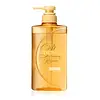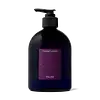What's inside
What's inside
 Key Ingredients
Key Ingredients

 Benefits
Benefits

 Concerns
Concerns

 Ingredients Side-by-side
Ingredients Side-by-side

Water
Skin ConditioningIsopentyldiol
HumectantStearyl Alcohol
EmollientBehentrimonium Chloride
PreservativeGlycerin
HumectantDimethicone
EmollientCetearyl Alcohol
EmollientBehenyl Alcohol
EmollientAminopropyl Dimethicone
Hydrogenated Polyisobutene
EmollientSteartrimonium Chloride
PreservativePolysilicone-13
Camellia Seed Oil
Lactic Acid
BufferingLysine Lauroyl Glutamate
CleansingSqualane
EmollientRoyal Jelly Extract
Skin ConditioningGlycine Max Seed Extract
Skin ConditioningIsopropyl Alcohol
SolventDipropylene Glycol
HumectantIsopropyl Myristate
EmollientPEG-2 Laurate
EmulsifyingSalicylic Acid
MaskingAmodimethicone
PPG-2-Deceth-12
EmulsifyingMethylserine
Skin ConditioningDisodium EDTA
Cetrimonium Chloride
AntimicrobialButylene Glycol
HumectantTocopherol
AntioxidantSodium Benzoate
MaskingPhenoxyethanol
PreservativeParfum
MaskingCI 17200
Cosmetic ColorantCI 15985
Cosmetic ColorantWater, Isopentyldiol, Stearyl Alcohol, Behentrimonium Chloride, Glycerin, Dimethicone, Cetearyl Alcohol, Behenyl Alcohol, Aminopropyl Dimethicone, Hydrogenated Polyisobutene, Steartrimonium Chloride, Polysilicone-13, Camellia Seed Oil, Lactic Acid, Lysine Lauroyl Glutamate, Squalane, Royal Jelly Extract, Glycine Max Seed Extract, Isopropyl Alcohol, Dipropylene Glycol, Isopropyl Myristate, PEG-2 Laurate, Salicylic Acid, Amodimethicone, PPG-2-Deceth-12, Methylserine, Disodium EDTA, Cetrimonium Chloride, Butylene Glycol, Tocopherol, Sodium Benzoate, Phenoxyethanol, Parfum, CI 17200, CI 15985
Water
Skin ConditioningSodium C14-16 Olefin Sulfonate
CleansingMaltodextrin
AbsorbentCocamidopropyl Betaine
CleansingLauramide Dipa
Emulsion StabilisingGlycerin
HumectantAloe Barbadensis Leaf Juice Powder
Skin ConditioningAmylopectin
Argania Spinosa Kernel Oil
EmollientAscorbyl Palmitate
AntioxidantCaprylyl Glycol
EmollientCedrus Atlantica Wood Oil
PerfumingCitric Acid
BufferingCoco-Glucoside
CleansingDextrin
AbsorbentDipropylene Glycol
HumectantEucalyptus Globulus Leaf/Twig Oil
MaskingFoeniculum Vulgare Oil
EmollientGlyceryl Oleate
EmollientGlyoxal
AntimicrobialGuar Hydroxypropyltrimonium Chloride
Skin ConditioningHydrogenated Palm Glycerides Citrate
EmollientIsopropyl Alcohol
SolventJuniperus Communis Fruit Oil
MaskingLactic Acid
BufferingLecithin
EmollientMelaleuca Alternifolia Leaf Oil
AntioxidantMentha Arvensis Piperascens Herb Oil
PerfumingMentha Viridis Leaf Oil
AstringentNiacinamide
SmoothingPhospholipids
Skin ConditioningPolydextrose
HumectantPolyquaternium-67
Polyquaternium-7
Rosmarinus Officinalis Leaf Oil
MaskingSalicylic Acid
MaskingSalvia Sclarea Oil
MaskingSimmondsia Chinensis Seed Oil
EmollientSodium Acetate
BufferingSodium Chloride
MaskingSodium Citrate
BufferingSodium Hydroxide
BufferingSodium Phytate
Sphingolipids
EmollientTocopherol
AntioxidantTocopheryl Acetate
AntioxidantChlorphenesin
AntimicrobialPhenoxyethanol
PreservativePotassium Sorbate
PreservativeSodium Benzoate
MaskingLimonene
PerfumingLinalool
PerfumingWater, Sodium C14-16 Olefin Sulfonate, Maltodextrin, Cocamidopropyl Betaine, Lauramide Dipa, Glycerin, Aloe Barbadensis Leaf Juice Powder, Amylopectin, Argania Spinosa Kernel Oil, Ascorbyl Palmitate, Caprylyl Glycol, Cedrus Atlantica Wood Oil, Citric Acid, Coco-Glucoside, Dextrin, Dipropylene Glycol, Eucalyptus Globulus Leaf/Twig Oil, Foeniculum Vulgare Oil, Glyceryl Oleate, Glyoxal, Guar Hydroxypropyltrimonium Chloride, Hydrogenated Palm Glycerides Citrate, Isopropyl Alcohol, Juniperus Communis Fruit Oil, Lactic Acid, Lecithin, Melaleuca Alternifolia Leaf Oil, Mentha Arvensis Piperascens Herb Oil, Mentha Viridis Leaf Oil, Niacinamide, Phospholipids, Polydextrose, Polyquaternium-67, Polyquaternium-7, Rosmarinus Officinalis Leaf Oil, Salicylic Acid, Salvia Sclarea Oil, Simmondsia Chinensis Seed Oil, Sodium Acetate, Sodium Chloride, Sodium Citrate, Sodium Hydroxide, Sodium Phytate, Sphingolipids, Tocopherol, Tocopheryl Acetate, Chlorphenesin, Phenoxyethanol, Potassium Sorbate, Sodium Benzoate, Limonene, Linalool
 Reviews
Reviews

Ingredients Explained
These ingredients are found in both products.
Ingredients higher up in an ingredient list are typically present in a larger amount.
Dipropylene Glycol is a synthetically created humectant, stabilizer, and solvent.
This ingredient helps:
Dipropylene glycol is technically an alcohol, but it belongs to the glycol family (often considered part of the ‘good’ alcohols). This means it is hydrating and gentle on skin unlike drying solvent alcohols like denatured alcohol.
As a masking agent, Dipropylene Glycol can be used to cover the smell of other ingredients. However, it does not have a scent.
Studies show Dipropylene Glycol is considered safe to use in skincare.
Learn more about Dipropylene GlycolGlycerin is already naturally found in your skin. It helps moisturize and protect your skin.
A study from 2016 found glycerin to be more effective as a humectant than AHAs and hyaluronic acid.
As a humectant, it helps the skin stay hydrated by pulling moisture to your skin. The low molecular weight of glycerin allows it to pull moisture into the deeper layers of your skin.
Hydrated skin improves your skin barrier; Your skin barrier helps protect against irritants and bacteria.
Glycerin has also been found to have antimicrobial and antiviral properties. Due to these properties, glycerin is often used in wound and burn treatments.
In cosmetics, glycerin is usually derived from plants such as soybean or palm. However, it can also be sourced from animals, such as tallow or animal fat.
This ingredient is organic, colorless, odorless, and non-toxic.
Glycerin is the name for this ingredient in American English. British English uses Glycerol/Glycerine.
Learn more about GlycerinIsopropyl Alcohol is more commonly known as rubbing alcohol. It is most commonly used as a solvent, meaning it helps other ingredients dissolve.
This ingredient is an astringent alcohol. Astringent alcohols may also irritate skin as they high amounts may strip away your skin's natural oils.
Other types of astringent alcohols include:
According to the National Rosacea Society based in the US, you should be mindful of products with these alcohols in the top half of ingredients.
Any type of sanitizing product will have high amounts of alcohol to help kill bacteria and viruses.
Learn more about Isopropyl AlcoholLactic Acid is another well-loved alpha hydroxy acid (AHA). It is gentler than glycolic acid but still highly effective.
Its main role is to exfoliate the surface of the skin by loosening the “glue” that holds dead skin cells together. Shedding those old cells leads to smoother, softer, and more even-toned skin.
Because lactic acid molecules are larger than glycolic acid, they don’t penetrate as deeply. This means they’re less likely to sting or irritate, making it a great choice for beginners or those with sensitive skin.
Like glycolic acid, it can:
Lactic acid also acts as a humectant (like hyaluronic acid). It can draw water into the skin to improve hydration and also plays a role in the skin's natural moisturizing factor (NMF) in the form of sodium lactate.
Studies show it can boost ceramide production to strengthen the skin barrier and even help balance the skin’s microbiome.
To get results, choose products with a pH between 3-4.
Lower strengths (5-12%) focus on surface exfoliation; higher strengths (12% and up) can reach deeper in the dermis (deeper, supportive layer) to improve skin texture and firmness over time.
Though it was originally derived from milk, most modern lactic acid used in skincare is vegan. It is made through non-dairy fermentation to create a bio-identical and stable form suitable for all formulations.
When lactic acid shows up near the end of an ingredient list, it usually means the brand added just a tiny amount to adjust the product’s pH.
Legend has it that Cleopatra used to bathe in sour milk to help reduce wrinkles.
Lactic acid is truly a gentle multitasker: it exfoliates, hydrates, strengthens, and brightens. It's a great ingredient for giving your skin a smooth, glowing, and healthy look without the harshness of stronger acids.
Read more about some other popular AHA's here:
Learn more about Lactic AcidPhenoxyethanol is a preservative that has germicide, antimicrobial, and aromatic properties. Studies show that phenoxyethanol can prevent microbial growth. By itself, it has a scent that is similar to that of a rose.
It's often used in formulations along with Caprylyl Glycol to preserve the shelf life of products.
Salicylic Acid (also known as beta hydroxy acid or BHA) is a well-known ingredient for treating skin that struggles with acne and clogged pores. It exfoliates both the skin's surface and deep within the pores to help clear out buildup, control oil, and reduce inflammation.
Unlike AHAs (alpha hydroxy acids), salicylic acid is oil-soluble. This allows it to penetrate into pores which makes it especially effective for treating blackheads and preventing future breakouts.
Salicylic acid is also known for its soothing properties. It has a similar structure to aspirin and can calm inflamed or irritated skin, making it a good option for acne-prone skin that is also sensitive.
Concentrations of 0.5-2% are recognized by the U.S. FDA as an over-the-counter topical acne product.
It can cause irritation and/or dryness if one's skin already has a compromised moisture barrier, so it's best to focus on repairing that before introducing this ingredient into your routine.
While salicylic acid does not increase sun sensitivity, it’s still important to wear sunscreen daily to protect your skin.
If you are looking for the ingredient called BHA or Butylated Hydroxyanisole, click here.
Learn more about Salicylic AcidSodium Benzoate is a preservative. It's used in both cosmetic and food products to inhibit the growth of mold and bacteria. It is typically produced synthetically.
Both the US FDA and EU Health Committee have approved the use of sodium benzoate. In the US, levels of 0.1% (of the total product) are allowed.
Sodium benzoate works as a preservative by inhibiting the growth of bacteria inside of cells. It prevents the cell from fermenting a type of sugar using an enzyme called phosphofructokinase.
It is the salt of benzoic acid. Foods containing sodium benzoate include soda, salad dressings, condiments, fruit juices, wines, and snack foods.
Studies for using ascorbic acid and sodium benzoate in cosmetics are lacking, especially in skincare routines with multiple steps.
We always recommend speaking with a professional, such as a dermatologist, if you have any concerns.
Learn more about Sodium BenzoateTocopherol (also known as Vitamin E) is a common antioxidant used to help protect the skin from free-radicals and strengthen the skin barrier. It's also fat soluble - this means our skin is great at absorbing it.
Vitamin E also helps keep your natural skin lipids healthy. Your lipid skin barrier naturally consists of lipids, ceramides, and fatty acids. Vitamin E offers extra protection for your skin’s lipid barrier, keeping your skin healthy and nourished.
Another benefit is a bit of UV protection. Vitamin E helps reduce the damage caused by UVB rays. (It should not replace your sunscreen). Combining it with Vitamin C can decrease sunburned cells and hyperpigmentation after UV exposure.
You might have noticed Vitamin E + C often paired together. This is because it is great at stabilizing Vitamin C. Using the two together helps increase the effectiveness of both ingredients.
There are often claims that Vitamin E can reduce/prevent scarring, but these claims haven't been confirmed by scientific research.
Learn more about TocopherolWater. It's the most common cosmetic ingredient of all. You'll usually see it at the top of ingredient lists, meaning that it makes up the largest part of the product.
So why is it so popular? Water most often acts as a solvent - this means that it helps dissolve other ingredients into the formulation.
You'll also recognize water as that liquid we all need to stay alive. If you see this, drink a glass of water. Stay hydrated!
Learn more about Water